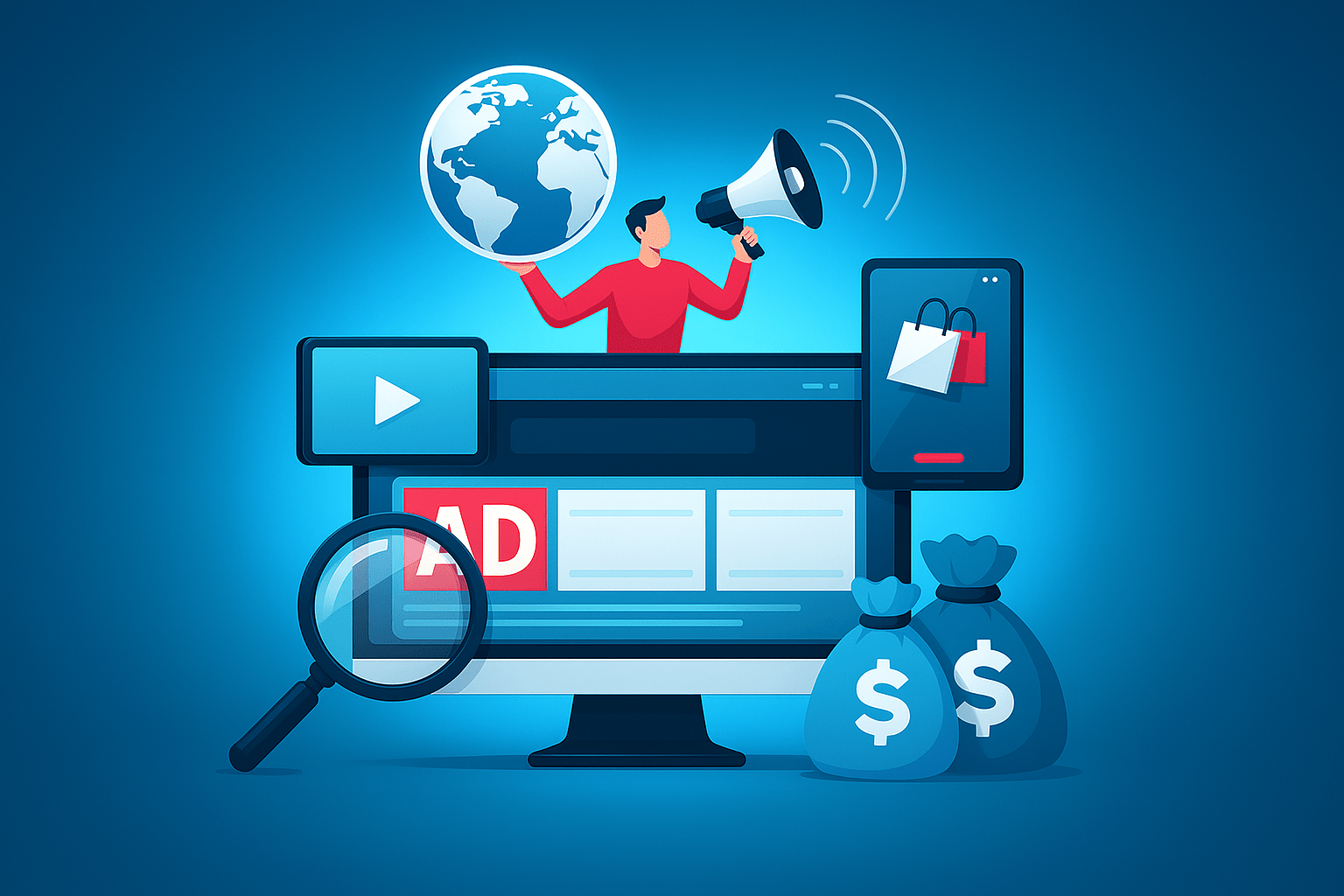Pioneering
Accounting
Acquisition
accountingprospects.com/blogs

The future of B2B marketing is multi-channel—and personal. As decision-making committees grow larger and buyer journeys become more complex, successful B2B marketers are abandoning siloed, single-channel approaches in favor of orchestrated omnichannel strategies. By coordinating personalized messaging across email sequences, LinkedIn outreach, and strategic ad retargeting, forward-thinking companies are creating seamless experiences that meet prospects wherever they are in their buying journey. This integrated approach doesn't just improve engagement metrics—it fundamentally transforms how B2B organizations generate pipeline, accelerate deals, and maximize customer lifetime value.
1. The Paradigm Shift: From Isolated Channels to Integrated Customer Experiences
B2B marketing is undergoing a comprehensive transformation where previously isolated marketing efforts are now converging in coordinated, multi-channel customer experiences. This shift is driven by both customer expectations and technological advances in marketing automation and data-driven personalization. According to comprehensive research from LinkedIn Business Insights, companies implementing integrated multi-channel strategies achieve 72% higher customer conversion rates compared to organizations relying on single-channel campaigns.
It's not just effectiveness that's changing—buyer behavior now demands this approach. With an average of 6-10 decision-makers involved in each B2B purchase decision and a buying journey encompassing 27 different information sources, marketers must create consistent, value-driven messaging that meets buyers on their terms and in their preferred channels.
- Data consolidation enables insight-based customer interactions across the entire buyer journey
- Cross-channel measurement creates a clearer picture of what truly drives conversions
- Consistent brand experience builds trust and recognition regardless of touchpoint
- Data-driven orchestration enables the right message to be delivered in the right channel at the right time
Successful omnichannel B2B strategies aren't just about being present in multiple channels—they're about creating a cohesive customer experience where each interaction builds upon previous engagement, regardless of channel.
2. The Central Role of Email in a Multi-Channel B2B Strategy
Despite the emergence of new communication channels, email remains the backbone of effective B2B marketing, especially when enhanced with AI-driven personalization and integrated with other channels. Today's sophisticated email platforms no longer just deliver static messages—they orchestrate dynamic conversations tailored to the recipient's engagement, needs, and buying stage.
As highlighted in an analytical deep dive from Justin Rowe's marketing analysis, modern B2B email communication is no longer about sending out mass emails and hoping for a response. Instead, leading marketers use behavior-based triggers, contextual content, and sequencing to create conversation-like experiences that adapt in real-time based on recipient actions.
- Intent-based sequencing adapts email flows based on digital buying signals
- Predictive content recommendation delivers the most relevant content for the recipient's specific buying stage
- Hybrid automation/sales models combine the efficiency of automation with the personal touch of human salespeople
- Engagement-based channel switching where email interactions can trigger follow-up via other channels
When integrated with LinkedIn and retargeting ads, email becomes even more powerful. An initial email opening can, for example, trigger a personal LinkedIn contact, while click behavior can activate segment-specific ads that reinforce the message and drive continued engagement.
3. LinkedIn as a Strategic Channel for B2B Relationship Building
LinkedIn has evolved from a simple recruitment platform to the most powerful tool for B2B relationship building and thought leadership establishment. The platform's unique combination of professional targeting, content distribution, and direct communication makes it a central component in every effective omnichannel B2B strategy.
A comprehensive study from CXL Institute shows that B2B marketers who combine organic LinkedIn outreach with strategic LinkedIn advertising and content publishing achieve 61% higher lead quality and 33% shorter sales cycles compared to traditional prospecting models.
Successful B2B organizations implement four core components in their LinkedIn strategy:
- Personal contact sequences built on shared connections, company events, and content engagement
- Strategic content publishing that positions the brand as a thought leader in specific topic verticals
- Account-Based Networking (ABN) where sales teams methodically build contact networks within target accounts
- Sophisticated LinkedIn advertising with advanced audience segmentation based on job title, company size, industry, and engagement signals
The real value emerges when LinkedIn activities are synchronized with email communication and advertising strategy. For example, a contact who engages with a LinkedIn post can automatically receive a personalized email follow-up with related content, while inactive LinkedIn connections can be prioritized for targeted ads that reactivate their interest.
4. Retargeting Ads as a Reinforcement Channel
Targeted ad retargeting functions as a critical reinforcement channel in a well-integrated B2B marketing strategy. By methodically displaying relevant ads to potential customers based on their previous interactions with your brand, you can dramatically improve recall effect, message reinforcement, and conversion rate.
According to an in-depth analysis from Search Engine Land, B2B companies that combine Google Ads and LinkedIn advertising in coordinated retargeting campaigns see an average increase of 58% in conversion rate and 37% lower acquisition cost per qualified lead.
- Channel-specific creative strategy adapts messaging and format for each advertising platform's unique context
- Sequential retargeting presents progressively evolving messages based on the audience's engagement level
- Content-driven advertising flow where ads recommend relevant content based on previous consumption patterns
- Intent-based bidding strategy that increases investments for the most purchase-ready segments
The most advanced implementations use dynamic ad customization where ad content automatically adjusts based on which content the contact has already engaged with via email or LinkedIn. This creates a context-aware experience where each ad impression builds on established knowledge rather than appearing disconnected from previous interactions.
5. Orchestrating Omnichannel B2B Campaigns
Effectively orchestrating omnichannel campaigns requires more than just parallel activation of multiple channels—it requires a thoughtful framework for how channels interact, reinforce each other, and create a seamless buying experience. Successful orchestration means each channel delivers the right message at the right time, based on where the buyer is in their journey.
A comprehensive guide from Workshop Digital shows how B2B organizations implement Account-Based Marketing principles to coordinate multi-channel campaigns with astonishing results: companies with well-orchestrated ABM programs report 91% higher average order value and 208% higher revenue from target accounts.
- Cross-channel contact plans define exact timing, sequence, and messaging for each touchpoint
- Integrated technology stacks ensure data flows seamlessly between marketing and sales platforms
- Unified data and insight model creates a holistic view of contact behavior across all channels
- Sales and marketing collaboration where digital signals drive coordinated human follow-ups
The key to successful orchestration lies in implementing structured planning processes where email, LinkedIn, and ad content are developed simultaneously with clear awareness of how they interact. Leading organizations also use "trigger mapping" to define exactly which events in one channel should activate follow-up activities in other channels.
6. Future Development: AI and Predictive Orchestration
While today's omnichannel strategies already deliver impressive results, the next wave of innovation points toward AI-driven, predictive channel selection and real-time personalization that will radically change how B2B marketers engage potential customers.
Forward-thinking organizations are already implementing the following capabilities:
- Intent-based channel optimization where AI automatically selects the most effective channel for each individual contact based on their historical engagement patterns
- Dynamic message adjustment that adapts tone, complexity, and content in real-time based on recipient response
- Predictive contact models that identify exactly when and how each potential customer should be contacted for maximum receptivity
- Automated insight sharing between marketing and sales teams ensuring that human interactions build upon all available contact data
The truly groundbreaking results come when omnichannel B2B marketing is integrated with predictive analytics that can anticipate which content, which channel, and which message has the highest likelihood of driving progression in the buying process for each individual contact. This enables a dynamic, responsive marketing strategy that continuously optimizes itself based on real-time feedback.
7. Implementation Framework: How to Get Started
Implementing an effective omnichannel B2B marketing strategy requires a structured approach. Here's a step-by-step process to get started, based on best practices from high-performing B2B organizations:
- Step 1: Evaluate the data landscape - Ensure you have a unified way to track interactions across all channels and that data flows seamlessly between systems
- Step 2: Map the buying journey - Document the key phases in your buying process and identify which channels are most effective in each phase
- Step 3: Develop cross-channel content strategy - Create coordinated message elements that can be adapted for each channel while conveying a consistent message
- Step 4: Implement trigger systems - Define exactly which events should trigger activities in other channels and configure your systems to support this
- Step 5: Establish measurement framework - Develop attribution and reporting that provides insight into how channels interact rather than just measuring each channel in isolation
The most successful implementations often begin with pilot programs focused on specific customer segments or product lines before scaling up. This enables rapid learning and optimization before the strategy is rolled out more broadly.
8. Conclusion: The Human Factor in Automated Marketing
Despite all technological advances and automation possibilities, the human factor remains crucial for truly effective B2B marketing. The organizations that succeed best with omnichannel marketing use technology to enhance human capabilities rather than replace them.
Successful strategies balance automation and personal contact by:
- Automating repetitive processes while focusing human creativity on strategy development
- Using AI for personalization but ensuring human oversight of tone and messaging
- Letting data inform decision-making but never replacing human intuition and experience
- Implementing clear handoff points where automation ends and human contact takes over
Ultimately, successful omnichannel B2B marketing is about delivering the right message, to the right person, in the right channel, at the right time—all supported by data and automation but guided by strategic human insight. The organizations that manage to balance these elements will see dramatically improved results across their entire marketing and sales operations.
More in Marketing
loyal accounting clients.

